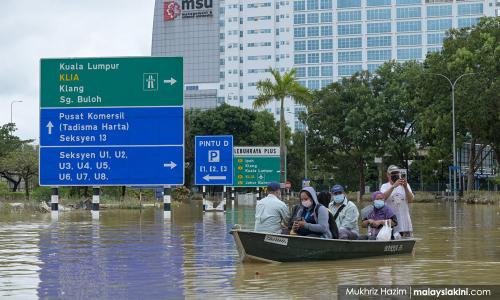LETTER | Forewarned but failed to prepare, again
LETTER | Kini Morning Brief is spot on the reality: the heavy rainfall - a month's worth of rain in a single day – wasn’t a "once in a 100 years" incident.
The last time an incident like this happened was not 100 years ago as officials have portrayed, but merely four years ago.
As a matter of fact, some of the worst floods to hit the country happened only in the last two decades, namely in 2006, 2007, 2010, 2014 and 2017 (see Malaysia: Disaster Management Reference Handbook, CFE-DM, 2019).
The flood of 2017 took place early in that year. Seasonal heavy rains beginning Jan 23, 2017 caused flooding in six states (Johor, Kelantan, Pahang, Perak, Selangor and Sabah).
The National Disaster Management Agency (Nadma), the army, the police and other local government agencies were deployed to conduct evacuations, established emergency shelters and evacuation centres, and provided disaster relief.
The Special Malaysia Disaster Assistance and Rescue (Smart) Team was also rushed to the affected areas to carry out Search and Rescue (SAR) operations. The Malaysian Red Crescent (MRC) emergency response capacity was not spared either to conduct water search and rescue, welfare services, and health and disaster relief.
Later in the year, in November 2017, hours of torrential rain caused flash flooding in Penang which killed at least seven people. The military forces were deployed to assist in the rescue of thousands who were displaced. Nearly 80 percent of the state was hit by typhoon-like winds and heavy rains – not unlike the ones that swept Selangor on Saturday.
More than 3,500 were evacuated in Penang. In neighbouring Kedah, more than 2,000 were forced to leave their homes.
The annual monsoon season then brought heavy rains which caused serious flooding to six states in January 2018. Almost 5,000 people in Pahang were evacuated. Kuantan was the worst affected district with 3,931 flood victims being housed in 22 temporary relief centres.
It was only three years before, in December 2014, that the country faced its worst monsoon flood which affected over half a million people across several states and caused extensive damage to infrastructure.
Due to the disaster and the number of growing climate change concerns, the country was said to have invested in adaptation and mitigation efforts in addition to improving its disaster risk management structure.
That should prepare the authorities for Disaster Risk Reduction (DRR), which is the concept and practice of reducing disaster risks through systematic efforts to analyse and reduce the causal factors of disasters.
Reducing exposure to hazards, lessening vulnerability of people and property, wise management of land and the environment, and improving preparedness for adverse events are all examples of disaster risk reduction.

Disaster risk reduction includes disciplines like disaster management, disaster mitigation and disaster preparedness (see United Nations International Strategy for Disaster Reduction, “What is Disaster Risk Reduction?”.
Similarly, the authorities should have been trained in disaster response following the first Malaysian Humanitarian Assistance and Disaster Response Civil-Military course where the US Centre for Excellence in Disaster Management and Humanitarian Assistance (CFE-DM) provided training alongside Nadma, International Federation of Red Cross and Red Crescent Societies, UN World Food Programme, Office of US Foreign Disaster Assistance, and Asean Coordinating Centre for Humanitarian Assistance on disaster management.
The event took place in Kuala Lumpur from April 17-19, 2019. Approximately 50 civilian and military disaster response stakeholders were in attendance to enhance their knowledge in disaster response and operationalise civil-military coordination at the national, regional and international levels, towards a common goal of disaster readiness and preparedness.
The CFE-DM publishes the Disaster Management Reference Handbook Series which are intended to provide decision-makers, planners, responders and disaster management practitioners with an overview of the disaster management structure, policies, laws, and plans for each country covered in the series.
Malaysia: Disaster Management Reference Handbook was published in June 2019, following the April 2019 Kuala Lumpur event, and offers a guide that brings together important information about disaster management and response in the country.
Despite that, the authorities were yet again unprepared for the Selangor flood on Saturday.
An effective response to disasters – natural or man-made – is a critical role of authorities, at every level. It requires planning, coordination and communication among authorities.
The authorities’ unpreparedness undermines confidence in their ability to plan, prepare for, and respond to disasters.
Will the authorities continue to be unprepared for the next disaster? God forbids.
According to the June 2019 publication, in the last two decades (1998-August 2018) over three million people were affected, and disasters caused nearly US$2 billion (RM8 billion) in damages.
Malaysia is susceptible to hazards including flooding, landslides, drought, and forest fires.
For a country profiled as “susceptible to hazards”, lack of readiness and preparedness is not an option. It is a failure.
The views expressed here are those of the author/contributor and do not necessarily represent the views of Malaysiakini.
RM12.50 / month
- Unlimited access to award-winning journalism
- Comment and share your opinions on all our articles
- Gift interesting stories to your friends
- Tax deductable
